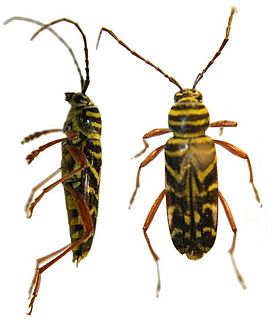Related Research Articles

Robinia pseudoacacia, commonly known in its native territory as black locust, is a medium-sized hardwood deciduous tree, belonging to the tribe Robinieae of the legume family Fabaceae. It is endemic to a few small areas of the United States, but it has been widely planted and naturalized elsewhere in temperate North America, Europe, Southern Africa and Asia and is considered an invasive species in some areas. Another common name is false acacia, a literal translation of the specific name.

Megacyllene robiniae, commonly known as the locust borer, is a species of longhorn beetle endemic to eastern North America. It is a serious pest of Robinia pseudoacacia, the black locust tree, with which it is sympatric.

Mesorhizobium is a genus of Gram-negative soil bacteria. At least one, the nitrogen fixing species, Mesorhizobium loti, forms symbiotic root nodules with plants in the genus Lotus. Strain MAFF303099 of M. japonicum has been fully sequenced.
Actinospica is a genus in the phylum Actinobacteria (Bacteria).
Mesorhizobium loti, formerly known as Rhizobium loti, is a Gram negative species of bacteria found in the root nodules of many plant species. Its name is a reference to Lotus corniculatus, a flowering plant from which it was originally isolated.
Mesorhizobium abyssinicae is a bacterium from the genus of Mesorhizobium which was isolated from root nodules of agroforestry legume trees in southern Ethiopia.
Mesorhizobium caraganae is a gram-negative, aerobic, non-spore-forming, motile bacteria from the genus of Mesorhizobium which was isolated from root nodules of Caragana microphyllain in the Beipiao City in the Liaoning Province in China.
Mesorhizobium hawassense is a bacterium from the genus of Mesorhizobium which was isolated from root nodules.
Mesorhizobium mediterraneum is a bacterium from the genus Mesorhizobium, which was isolated from root nodule of the Chickpea in Spain. The species Rhizobium mediterraneum was subsequently transferred to Mesorhizobium mediterraneum. This species, along with many other closely related taxa, have been found to promote production of chickpea and other crops worldwide by forming symbiotic relationships.
Mesorhizobium metallidurans is a gram-negative, aerobic, non-spore-forming bacteria from the genus Mesorhizobium which was isolated from root nodules of Anthyllis vulneraria in the spoil heaps from the heavy metal enriched Laurent le Minier located in the Languedoc in France.
Mesorhizobium qingshengii is a bacterium from the genus Mesorhizobium which was isolated from root nodules of Astragalus sinicus in the southeast of China.
Mesorhizobium sangaii is a bacterium from the genus Mesorhizobium which was isolated from root nodules of Astragalus luteolus and Astragalus ernestii in the Sichuan Province in China.
Mesorhizobium shangrilense is a gram-negative, aerobic, non-spore-forming bacterium from the genus Mesorhizobium which was isolated from root nodules of Caragana bicolor which were found in Deqin City in the Yunnan Province in China.
Mesorhizobium shonense is a bacterium from the genus Mesorhizobium which was isolated in southern Ethiopia.
Mesorhizobium silamurunense is a bacterium from the genus Mesorhizobium which was isolated in China.
Tardiphaga is a genus of bacteria from the family of Bradyrhizobiaceae.
Tardiphaga robiniae is a Gram-negative and rod-shaped bacteria from the family of Tardiphaga which has been isolated from Robinia pseudoacacia root nodules.
Streptomyces samsunensis is a bacterium species from the genus of Streptomyces which has been isolated from the rhizosphere from the tree Robinia pseudoacacia from the Ondokuz Mayıs University in Samsun in Turkey.
Mesorhizobium acaciae is a bacterium from the genus of Mesorhizobium which has been isolated from the nodules of the tree Acacia melanoxylon in Guangdong in China.
Mesorhizobium calcicola is a Gram-negative and rod-shaped bacterium from the genus of Mesorhizobium which has been isolated from the root nodules of the tree Sophora in New Zealand.
References
- ↑ LSPN lpsn.dsmz.de
- ↑ Straininfo of Mesorhizobium robiniae
- ↑ Zhou, P. F.; Chen, W. M.; Wei, G. H. (2009). "Mesorhizobium robiniae sp. nov., isolated from root nodules of Robinia pseudoacacia". International Journal of Systematic and Evolutionary Microbiology. 60 (11): 2552–2556. doi: 10.1099/ijs.0.019356-0 . PMID 20008111.
- ↑ UniProt